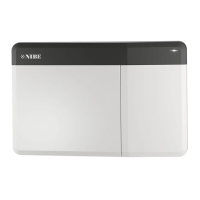The number of steps the value has to be changed in
order to achieve a one degree change to the indoor
temperature depends on the climate system. One step
is usually enough, but in some cases several steps may
be required.
Set the desired value. The new value is shown on the
right-hand side of the symbol on home screen heat-
ing/home screen cooling.
Caution
An increase in the room temperature can be
slowed by the thermostats for the radiators or
under floor heating. Therefore, open the ther-
mostats fully, except in those rooms where a
cooler temperature is required, e.g. bedrooms.
TIP
Wait 24 hours before making a new setting,
so that the room temperature has time to sta-
bilise.
If it is cold outdoors and the room temperature
is too low, increase the curve slope in menu
1.30.1 by one increment.
If it is cold outdoors and the room temperature
is too high, reduce the curve slope in menu
1.30.1 by one increment.
If it is warm outdoors and the room temperat-
ure is too low, increase the value in menu 1.1.1
by one increment.
If it is warm outdoors and the room temperat-
ure is too high, reduce the value in menu 1.1.1
by one increment.
MENU 1.2 - VENTILATION
This menu is lit if the installation contains one or more
ventilation accessories.
You make the settings for the ventilation in the installa-
tion here. For example, you can adjust the fan speed
and set how frequently SMO S40 will remind you of
when air filters need replacing.
MENU 1.3 - ROOM SENSOR SETTINGS
Name room sensor
Enter a name for the relevant room sensor.
Control room sensor
Setting range: on/off
Activate room sensors to control the room temperature
here.
You can connect several room sensors to each zone,
and you can give each room sensor a unique name.
Caution
A slow heating system such as underfloor
heating may be inappropriate for controlling
with room sensors.
MENU 1.3.4 - ZONES
Here, you name and add new zones.
MENU 1.4 EXTERNAL IMPACT
Information for the accessories/functions that can affect
the indoor climate and that are active is shown here.
MENU 1.5 - CLIMATE SYSTEM NAME
You can give the installation's climate system a name
here.
MENU 1.30 - ADVANCED
Menu advanced is intended for the advanced user. This
menu has several sub-menus.
Curve, heating Setting the heating curve slope.
Curve, cooling Setting the curve slope for cooling.
External adjustment Setting the heating curve offset
when an external contact is connected.
Lowest supply heating Setting minimum permitted
supply temperature during heating operation.
Lowest supply cooling Setting minimum permitted
supply temperature when cooling.
Highest supply heating Setting maximum permitted
supply temperature for the climate system.
Own curve You can create your own heating curve
here, if there are special requirements, by setting the
desired supply temperatures for different outdoor tem-
peratures.
Point offset Select a change in the heating curve at a
certain outdoor temperature here. One step is usually
enough to change the room temperature by one degree,
but in some cases several steps may be required.
MENU 1.30.1 - CURVE, HEATING
Curve, heating
Setting range: 0 – 15,0
In menu "Curve, heating" you can view the heating curve
for your house. The task of the heating curve is to
provide an even indoor temperature, regardless of the
outdoor temperature. It is from this heating curve that
SMO S40 determines the temperature of the water to
the climate system, the supply temperature, and there-
fore the indoor temperature. Here, you can select heat-
ing curve and read off how the supply temperature
changes at different outdoor temperatures.
39Chapter 9 | Control – MenusNIBE SMO S40

